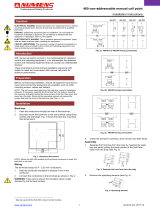6 Rittal cooling unit assembly instructions
3 Device description
GB
3.1.4 Safety equipment
– In the cooling cycle, the cooling unit has a tested
pressure-operated switch to EN 12 263 which is
set to maximum PS (admissible pressure); this
operates via an automatic reset device whenever
the pressure drops again.
– Temperature monitoring prevents the evaporator
coil from icing over. If there is a risk of icing over,
the compressor switches itself off and automati-
cally switches itself on again at higher tempera-
tures.
– The refrigerant compressor and the fans are
equipped with thermal winding shields to protect
against excess current and excess temperatures.
– In order to allow a reduction of pressure inside the
compressor and hence a safe restart, once it has
been switched off (e.g. upon reaching the set tem-
perature via the door limit switch function or via de-
energising), the device will switch back on with a
delay of 180 seconds.
– The device has one (in the case of the Basic con-
troller) or two (in the case of the Comfort controller)
integral floating contacts on the connection clamp
(system message relay with changeover contact,
terminal 3 – 5) which may be used to retrieve
messages from the cooling unit, e.g. via PLC.
3.1.5 Condensation
At high levels of humidity and low temperatures
inside the enclosure, condensation may form on the
evaporator coil.
The cooling units (except SK 3302.xxx, SK 3303.xxx
and SK 3361.xxx) have automatic, electric conden-
sate evaporation. The thermal component used for
this purpose is based on self-regulating PTC tech-
nology. Condensation arising on the evaporator coil
is collected in a tank in the external circuit of the
cooling unit, and partially evaporated via the airflow.
When the water level rises, the water enters the PTC
thermal component and is evaporated (through-flow
principle). The water vapour flows out of the cooling
unit with the airflow from the external fan.
The PTC thermal component is permanently con-
nected and has no switchpoint. It is protected
against short-circuits with miniature fuses. If the fuse
has tripped, any condensation is drained off via the
safety overflow.
For unit types SK 3302.xxx, SK 3303.xxx and
SK 3361.xxx, the condensation is routed downwards
out of the unit via a drain pipe on the evaporator coil
divider panel. For this purpose, a hose must be con-
nected to the condensate nozzle (see “4.4 Connect-
ing the condensate drain”, page 11). External con-
densate evaporators are available as accessories
for these unit types (refer also to the accessories in
the Rittal Catalogue).
3.1.6 Filter mats
The entire condenser in the cooling units is finished
with a dirt-repelling, easy-to-clean RiNano coating.
In many cases, therefore, the use of filter media is
unnecessary, particularly in the case of dry dusts.
For coarse dust and lint in the enclosure air, we
recommend installing an additional PU foam filter
mat (available as an accessory) in the cooling unit.
Depending on the incidence of dust, you will need to
replace the filter from time to time.
For air containing oil condensation, we recommend
the use of metal filters (also available as an acces-
sory). These may be cleaned with suitable deter-
gents and reused.
Function of the filter mat monitor:
Dirt on the filter mat is automatically determined by
measuring the temperature difference in the external
circuit of the cooling unit. As the level of filter mat
soiling rises, the temperature difference will increase.
The nominal value of the temperature difference in
the external circuit adapts automatically to the rele-
vant operating points in the performance diagrams.
Hence there is no need to readjust the nominal value
for different unit operating points.
3.1.7 Door limit switch
The cooling unit may be operated with a door limit
switch connected. The door limit switch is not
included with the supply (available as an accessory,
Model No. PS 4127.000).
The door limit switch function causes the fans and
the compressor to be switched off after approxi-
mately 15 seconds when the enclosure door is
opened (contacts 1 and 2 closed). This prevents the
formation of condensation inside the enclosure while
the enclosure door is open. In order to prevent dam-
age to the unit, it is equipped with an ON delay: The
evaporator fan cuts back in with a delay of approxi-
mately 15 seconds after the door has been closed,
while the condenser fan and compressor switch on
after approximately 3 minutes.
Note:
For Basic controller cooling units with
230/115 V and 400 V/2-phase connection,
the evaporator fan remains operational
even with the door open.





















